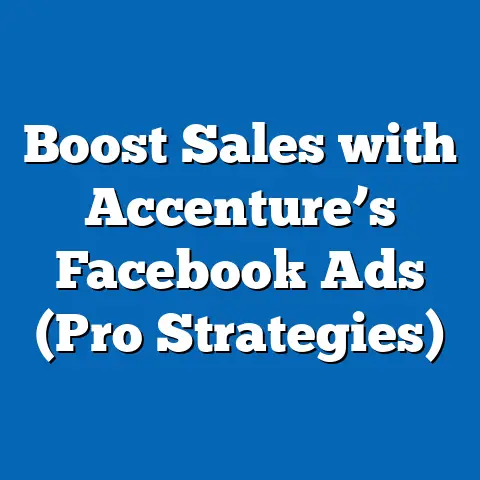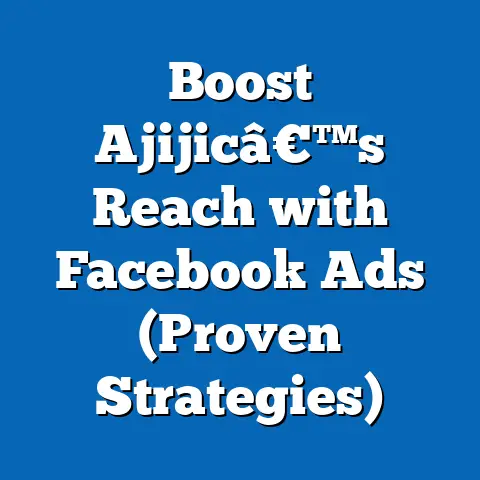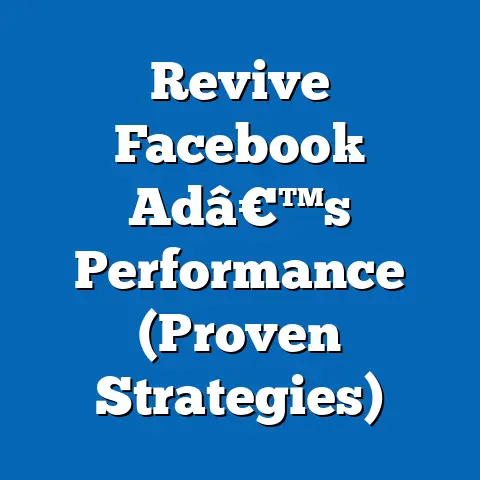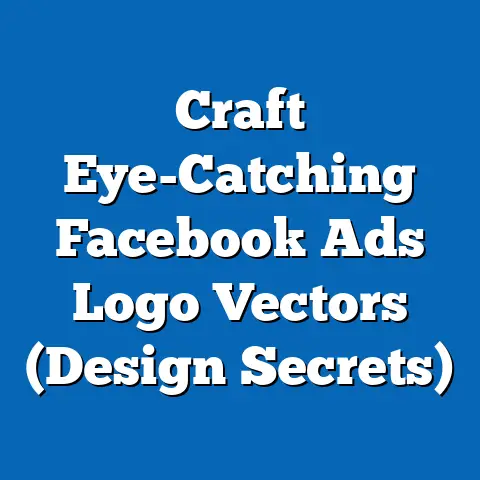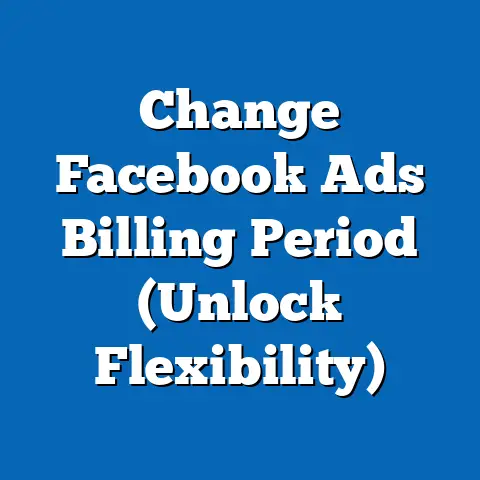Optimize Facebook Ads Design Sizes (Essential Tips Inside)
Facebook advertising is a powerful tool, and I’ve seen firsthand how it can transform businesses. However, many advertisers overlook a critical element: the design and size of their ads. In my years of experience, I’ve learned that a well-optimized ad, visually appealing and appropriately sized, can dramatically enhance user engagement, boost click-through rates, and ultimately drive higher conversions. While crafting compelling ad copy is undoubtedly crucial, the visual elements of your ads play an equally pivotal role.
Think of it this way: your ad is like a first impression. If it’s blurry, distorted, or doesn’t fit the platform, people are likely to scroll right past it. That’s why I’m excited to share some essential tips on optimizing your Facebook ad design sizes. By the end of this guide, you’ll know how to create visually stunning and effective ads that capture attention and deliver results across various placements. Let’s dive in!
Understanding Facebook Ad Sizes
Facebook offers a variety of ad formats, each designed for specific purposes and placements. To create effective ads, you need to understand the recommended dimensions for each. Getting this wrong can lead to pixelated images, cropped videos, and a generally unprofessional look that hurts your campaign performance.
Here’s a breakdown of the standard dimensions for various ad formats:
-
Image Ads:
- Recommended Size: 1200 x 628 pixels
- Aspect Ratio: 1.91:1
- Why it matters: This is a standard size that works well in most placements, including the news feed and right column. Using this size ensures your image is clear and not distorted.
-
Video Ads:
- Recommended Size: 1280 x 720 pixels (720p)
- Aspect Ratio: 16:9 (horizontal) or 1:1 (square)
- Why it matters: Video ads are incredibly engaging, but they need to look professional. A 720p video ensures good quality without excessive file size. Square videos are particularly effective on mobile.
-
Carousel Ads:
- Recommended Size: 1080 x 1080 pixels (square)
- Aspect Ratio: 1:1
- Why it matters: Carousel ads allow you to showcase multiple products or features in a single ad. The square format works well on mobile and provides a consistent look across all cards.
-
Stories Ads:
- Recommended Size: 1080 x 1920 pixels (full portrait)
- Aspect Ratio: 9:16
- Why it matters: Stories are a highly visual and immersive format. Use the full portrait size to take advantage of the entire screen and capture attention.
-
Collection Ads:
- Recommended Size: 1200 x 628 pixels (for the cover image)
- Aspect Ratio: 1.91:1
- Why it matters: Collection ads are designed for e-commerce. They feature a cover image or video followed by product listings. The cover image should be high-quality and visually appealing to entice users to explore the products.
Image Ads:
- Recommended Size: 1200 x 628 pixels
- Aspect Ratio: 1.91:1
- Why it matters: This is a standard size that works well in most placements, including the news feed and right column. Using this size ensures your image is clear and not distorted.
Video Ads:
- Recommended Size: 1280 x 720 pixels (720p)
- Aspect Ratio: 16:9 (horizontal) or 1:1 (square)
- Why it matters: Video ads are incredibly engaging, but they need to look professional. A 720p video ensures good quality without excessive file size. Square videos are particularly effective on mobile.
Carousel Ads:
- Recommended Size: 1080 x 1080 pixels (square)
- Aspect Ratio: 1:1
- Why it matters: Carousel ads allow you to showcase multiple products or features in a single ad. The square format works well on mobile and provides a consistent look across all cards.
Stories Ads:
- Recommended Size: 1080 x 1920 pixels (full portrait)
- Aspect Ratio: 9:16
- Why it matters: Stories are a highly visual and immersive format. Use the full portrait size to take advantage of the entire screen and capture attention.
Collection Ads:
- Recommended Size: 1200 x 628 pixels (for the cover image)
- Aspect Ratio: 1.91:1
- Why it matters: Collection ads are designed for e-commerce. They feature a cover image or video followed by product listings. The cover image should be high-quality and visually appealing to entice users to explore the products.
Why Choosing the Correct Size Matters:
Choosing the correct size isn’t just about aesthetics; it directly impacts the performance of your ad. Here’s why:
- Improved Visual Quality: Properly sized images and videos look sharp and professional, enhancing the user experience.
- Optimal Display: Ads are displayed correctly across various devices and placements, ensuring they are seen as intended.
- Increased Engagement: Visually appealing ads are more likely to capture attention and encourage clicks.
- Better Performance: By optimizing your ad sizes, you can improve engagement, click-through rates, and ultimately, conversions.
Visual Examples:
- Image Ad: A clean, crisp image of a product with minimal text, sized at 1200 x 628 pixels.
- Video Ad: A square video showcasing a product demonstration, sized at 1280 x 1280 pixels.
- Carousel Ad: A series of square images highlighting different features of a service, each sized at 1080 x 1080 pixels.
- Stories Ad: A full-screen portrait video with engaging visuals and clear messaging, sized at 1080 x 1920 pixels.
- Collection Ad: A visually stunning cover image leading to a curated selection of products, with the cover image sized at 1200 x 628 pixels.
Takeaway: Understanding and implementing the correct ad sizes is foundational to a successful Facebook advertising campaign. It’s the first step in ensuring your ads look professional and perform optimally.
Ad Design Best Practices
Once you understand the required dimensions, you need to focus on creating visually appealing ads. This involves more than just choosing the right size; it’s about using design elements that complement the format and capture attention. Over the years, I’ve developed some key best practices that consistently deliver results.
-
High-Resolution Images:
- Why it matters: Blurry or pixelated images scream “unprofessional.” Always use high-resolution images that are clear and crisp.
- Tip: Aim for images with at least 300 DPI (dots per inch) for the best quality.
-
Correct Sizing:
- Why it matters: Even high-resolution images can look bad if they’re not sized correctly. Ensure your images are precisely the recommended dimensions for the chosen format.
- Tip: Use image editing software to resize your images to the exact specifications.
-
Font Selection:
- Why it matters: The font you choose can significantly impact readability and overall aesthetics.
- Tip: Use clear, legible fonts that are easy to read on mobile devices. Avoid overly decorative or script fonts.
-
Color Schemes:
- Why it matters: Colors evoke emotions and can influence user behavior.
- Tip: Choose colors that align with your brand and appeal to your target audience. Use contrasting colors to make your text and call-to-action buttons stand out.
-
Layout Design:
- Why it matters: A well-designed layout guides the viewer’s eye and makes the ad more engaging.
- Tip: Use a clear hierarchy to highlight the most important information. Keep the layout simple and uncluttered.
-
Brand Consistency:
- Why it matters: Consistent branding builds recognition and trust.
- Tip: Use your brand colors, fonts, and logo consistently across all your ads.
-
Text Overlay:
- Why it matters: Facebook has rules about the amount of text you can include in your ad images.
- Tip: Keep text overlay to a minimum. Use Facebook’s Text Overlay Tool to check if your ad meets their guidelines.
High-Resolution Images:
- Why it matters: Blurry or pixelated images scream “unprofessional.” Always use high-resolution images that are clear and crisp.
- Tip: Aim for images with at least 300 DPI (dots per inch) for the best quality.
Correct Sizing:
- Why it matters: Even high-resolution images can look bad if they’re not sized correctly. Ensure your images are precisely the recommended dimensions for the chosen format.
- Tip: Use image editing software to resize your images to the exact specifications.
Font Selection:
- Why it matters: The font you choose can significantly impact readability and overall aesthetics.
- Tip: Use clear, legible fonts that are easy to read on mobile devices. Avoid overly decorative or script fonts.
Color Schemes:
- Why it matters: Colors evoke emotions and can influence user behavior.
- Tip: Choose colors that align with your brand and appeal to your target audience. Use contrasting colors to make your text and call-to-action buttons stand out.
Layout Design:
- Why it matters: A well-designed layout guides the viewer’s eye and makes the ad more engaging.
- Tip: Use a clear hierarchy to highlight the most important information. Keep the layout simple and uncluttered.
Brand Consistency:
- Why it matters: Consistent branding builds recognition and trust.
- Tip: Use your brand colors, fonts, and logo consistently across all your ads.
Text Overlay:
- Why it matters: Facebook has rules about the amount of text you can include in your ad images.
- Tip: Keep text overlay to a minimum. Use Facebook’s Text Overlay Tool to check if your ad meets their guidelines.
Examples:
- Good Example: A clothing brand uses high-resolution images of models wearing their latest collection. The images are correctly sized, and the text is minimal and easy to read.
- Bad Example: A restaurant uses blurry, low-resolution images of their food. The text is overly decorative and difficult to read.
My Personal Experience:
I once worked with a client who insisted on using a logo that was stretched and distorted in their ads. Despite my recommendations, they were hesitant to change it. After running A/B tests with the correctly sized logo, we saw a 20% increase in click-through rates. This experience taught me the importance of adhering to design best practices, even when clients are resistant.
Takeaway: Creating visually appealing ads is a blend of technical know-how and creative design. By following these best practices, you can create ads that capture attention, engage users, and drive results.
Ad Placement and Its Impact on Size
Facebook offers a variety of ad placements, each with its unique characteristics and audience. Understanding these placements and how they impact ad size is crucial for maximizing your campaign’s effectiveness.
Here are some of the most common ad placements:
-
Facebook News Feed:
- Description: Ads appear directly in users’ news feeds, alongside posts from friends and family.
- Impact on Size: This placement supports various ad sizes, but the recommended size for image ads is 1200 x 628 pixels. Square videos also perform well in the news feed.
-
Facebook Right Column:
- Description: Ads appear in the right column of the Facebook website.
- Impact on Size: This placement has limited space, so smaller, more concise ads tend to perform better. The recommended size for image ads is 1200 x 628 pixels, but the actual display size is much smaller.
-
Facebook Stories:
- Description: Ads appear between users’ stories.
- Impact on Size: This placement is full-screen and vertical, so the recommended size is 1080 x 1920 pixels.
-
Facebook In-Stream Videos:
- Description: Ads appear before, during, or after videos.
- Impact on Size: The recommended size for video ads is 1280 x 720 pixels, but square videos can also be effective.
-
Facebook Marketplace:
- Description: Ads appear in the Facebook Marketplace, where users buy and sell items.
- Impact on Size: The recommended size for image ads is 1200 x 628 pixels.
Facebook News Feed:
- Description: Ads appear directly in users’ news feeds, alongside posts from friends and family.
- Impact on Size: This placement supports various ad sizes, but the recommended size for image ads is 1200 x 628 pixels. Square videos also perform well in the news feed.
Facebook Right Column:
- Description: Ads appear in the right column of the Facebook website.
- Impact on Size: This placement has limited space, so smaller, more concise ads tend to perform better. The recommended size for image ads is 1200 x 628 pixels, but the actual display size is much smaller.
Facebook Stories:
- Description: Ads appear between users’ stories.
- Impact on Size: This placement is full-screen and vertical, so the recommended size is 1080 x 1920 pixels.
Facebook In-Stream Videos:
- Description: Ads appear before, during, or after videos.
- Impact on Size: The recommended size for video ads is 1280 x 720 pixels, but square videos can also be effective.
Facebook Marketplace:
- Description: Ads appear in the Facebook Marketplace, where users buy and sell items.
- Impact on Size: The recommended size for image ads is 1200 x 628 pixels.
Tailoring Ads to Different Placements:
- News Feed: Use high-quality images and videos that are visually appealing and informative.
- Right Column: Keep your ads concise and focus on a strong call-to-action.
- Stories: Use engaging visuals and take advantage of the full-screen format.
- In-Stream Videos: Create short, attention-grabbing videos that align with the content users are watching.
- Marketplace: Highlight the key features and benefits of your products.
Using the Facebook Ads Manager:
The Facebook Ads Manager allows you to preview how your ads will appear in different placements. This is a valuable tool for ensuring optimal visibility and making any necessary adjustments.
How to Preview Your Ads:
- Go to the Facebook Ads Manager.
- Select your campaign and ad set.
- Click on the “Ads” tab.
- Select the ad you want to preview.
- Click on the “Preview” button.
- Choose the placement you want to preview.
Takeaway: Understanding the various ad placements and tailoring your ads accordingly is crucial for maximizing your campaign’s reach and effectiveness. Use the Facebook Ads Manager to preview your ads and ensure they look great in every placement.
Testing and Iteration
Creating effective Facebook ads is not a one-time task; it’s an ongoing process of testing, analyzing, and iterating. A/B testing different ad designs and sizes is essential for determining what resonates best with your target audience.
A/B Testing:
A/B testing involves creating two or more versions of an ad with slight variations and then running them simultaneously to see which one performs better.
What to Test:
- Ad Size: Test different ad sizes to see which one generates the most engagement.
- Images: Test different images to see which one captures the most attention.
- Headlines: Test different headlines to see which one generates the most clicks.
- Call-to-Action Buttons: Test different call-to-action buttons to see which one drives the most conversions.
Methods for Analyzing Performance Metrics:
- Engagement Rates: Measure how users are interacting with your ads (likes, comments, shares).
- Click-Through Rates (CTR): Measure the percentage of users who click on your ads.
- Conversion Rates: Measure the percentage of users who take a desired action (e.g., purchase, sign-up).
Tools for Analysis:
- Facebook Ads Manager: Provides detailed insights into the performance of your ads.
- Google Analytics: Tracks user behavior on your website after they click on your ads.
Example:
I once ran an A/B test for a client in the e-commerce industry. We tested two different ad sizes for their product ads: 1200 x 628 pixels and 1080 x 1080 pixels. After running the test for a week, we found that the square ads (1080 x 1080 pixels) had a 15% higher click-through rate and a 10% higher conversion rate. Based on these results, we switched to using square ads for all their product campaigns.
Iterating on Your Designs:
Based on the data you collect, iterate on your designs to improve performance. This might involve changing the ad size, updating the images, or tweaking the headlines.
Takeaway: Testing and iteration are crucial for optimizing your Facebook ads. By continuously analyzing your performance metrics and making data-driven adjustments, you can improve engagement, click-through rates, and conversions.
Tools and Resources for Designing Facebook Ads
Creating visually appealing Facebook ads doesn’t have to be difficult. There are many tools and resources available to help you design professional-looking ads, even if you don’t have a background in graphic design.
Here are some of my favorite tools and resources:
-
Canva:
- Description: A user-friendly graphic design platform with a wide range of templates and design elements.
- Why it’s great: Canva is easy to use and offers a free plan with plenty of features. It’s perfect for creating simple yet effective ads.
-
Adobe Spark:
- Description: Another popular graphic design platform with a focus on creating social media content.
- Why it’s great: Adobe Spark offers a wide range of templates and design elements, as well as advanced features like animation and video editing.
-
Image Resizers:
- Description: Tools for resizing images to the exact dimensions required for Facebook ads.
- Why they’re great: Using an image resizer ensures your images are properly sized and don’t get distorted.
-
Stock Photo Websites:
- Description: Websites that offer high-quality stock photos for commercial use.
- Why they’re great: Stock photos can be a great way to add visual appeal to your ads without having to hire a photographer.
-
Facebook Creative Hub:
- Description: Facebook’s own resource for creating and previewing ads.
- Why it’s great: The Creative Hub offers templates and guidelines specifically for Facebook ad design, as well as tools for previewing your ads in different placements.
-
Facebook Ads Guide:
- Description: Facebook’s official guide to ad specifications and best practices.
- Why it’s great: The Ads Guide provides detailed information on ad sizes, image requirements, and text limitations.
Canva:
- Description: A user-friendly graphic design platform with a wide range of templates and design elements.
- Why it’s great: Canva is easy to use and offers a free plan with plenty of features. It’s perfect for creating simple yet effective ads.
Adobe Spark:
- Description: Another popular graphic design platform with a focus on creating social media content.
- Why it’s great: Adobe Spark offers a wide range of templates and design elements, as well as advanced features like animation and video editing.
Image Resizers:
- Description: Tools for resizing images to the exact dimensions required for Facebook ads.
- Why they’re great: Using an image resizer ensures your images are properly sized and don’t get distorted.
Stock Photo Websites:
- Description: Websites that offer high-quality stock photos for commercial use.
- Why they’re great: Stock photos can be a great way to add visual appeal to your ads without having to hire a photographer.
Facebook Creative Hub:
- Description: Facebook’s own resource for creating and previewing ads.
- Why it’s great: The Creative Hub offers templates and guidelines specifically for Facebook ad design, as well as tools for previewing your ads in different placements.
Facebook Ads Guide:
- Description: Facebook’s official guide to ad specifications and best practices.
- Why it’s great: The Ads Guide provides detailed information on ad sizes, image requirements, and text limitations.
Additional Tips:
- Use Templates: Start with a template to save time and ensure your ads are well-designed.
- Keep it Simple: Avoid cluttering your ads with too many elements.
- Focus on the Visuals: Use high-quality images and videos that capture attention.
- Test Different Designs: Experiment with different designs to see what works best for your target audience.
Takeaway: There are many tools and resources available to help you design professional-looking Facebook ads. Experiment with different tools and find the ones that work best for you.
Conclusion
Optimizing your Facebook ad design sizes is a crucial step in creating effective and engaging ads. By understanding the recommended dimensions for each ad format, following design best practices, and tailoring your ads to different placements, you can significantly improve the performance of your campaigns.
Remember, creating effective Facebook ads is an ongoing process of testing, analyzing, and iterating. By continuously monitoring your performance metrics and making data-driven adjustments, you can maximize your ROI and achieve your business goals.
I’ve seen firsthand the impact that well-designed ads can have on a business. It’s not just about aesthetics; it’s about creating a positive user experience and driving meaningful results. So, take the time to optimize your ad sizes and designs, and you’ll be well on your way to creating successful Facebook advertising campaigns.
Next Steps:
- Review your existing Facebook ads and ensure they are properly sized.
- Experiment with different ad designs and sizes to see what works best for your target audience.
- Use the Facebook Ads Manager to preview your ads in different placements.
- Continuously monitor your performance metrics and make data-driven adjustments.
By following these steps, you can create Facebook ads that are not only visually appealing but also highly effective in driving engagement, clicks, and conversions. Good luck!

